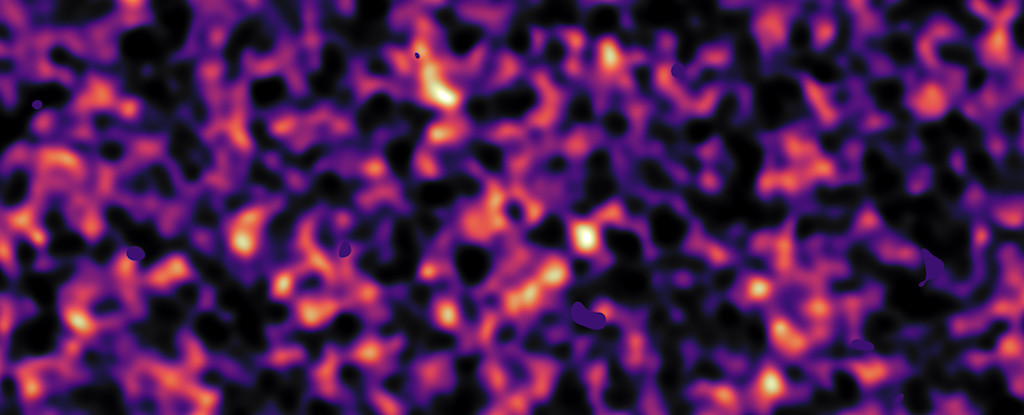Thanks to gravity, at least we’re aware dark matter exists. We also know it’s eerily abundant, accounting for about 85 percent of all matter in the Universe.
Aside from that, though, we’re pretty clueless. We don’t know what dark matter is or where it came from, and if it is made of some kind of weakly-interacting form of matter, we still can’t directly detect a single particle of it.
According to a theoretical study by two researchers from Colgate University in the US, our ongoing failure to unmask dark matter – even with newer, highly sensitive detection methods – warrants rethinking the nature and potential origins of this mysterious stuff.
Rather than emerging from the Big Bang along with ordinary baryonic matter, dark matter could have arisen slightly later in its own ‘Dark Big Bang,’ the study’s authors write. It may now inhabit a dark sector mostly detached from our visible sector, interacting exclusively through gravity.
Gravity has taught us what little we do know about dark matter so far. We call the ghostly substance dark matter because it doesn’t interact with light or other electromagnetic radiation, rendering it invisible to us.
Yet given its gravitational sway on galaxies and galaxy clusters – plus other clues, like its effect on the cosmic background radiation – we have strong evidence dark matter exists. We’re just still in the dark about nearly everything else, including what it is and where it came from.
The hunt for dark matter has focused largely on weakly interacting massive particles, or WIMPs. These hypothetical elementary particles would interact via two of the four fundamental forces: gravity and the weak nuclear force (but not electromagnetism or the strong nuclear force).
Decades of searching have yielded no confirmation of WIMPs’ existence, dimming their allure a bit and displacing more scientific interest toward other possible explanations of dark matter.
“As WIMPs continue to evade detection, it is becoming increasingly important to consider dark sectors that are strongly decoupled from the visible sector,” write the authors of the new study, physicist Cosmin Ilie and undergraduate researcher Richard Casey.
In 2023, two other researchers – Katherine Freese and Martin Winkler from the University of Texas at Austin – proposed an intriguing theory: Maybe dark matter was formed separately to the initial cosmic expansion in a second big bang, which they dubbed the Dark Big Bang.
That would challenge the way many scientists currently envision this pivotal era, with all matter and radiation in the Universe (including dark matter, whatever it is) originating from the same sector of physics.
According to Freese and Winkler, however, a Dark Big Bang is consistent with the evidence for dark matter – as long as it happened promptly, within about a month of the first Big Bang.
In this scenario, dark matter particles arise from the decay of a quantum field that couples only to the dark or hidden sector; a hypothetical assortment of particles and forces beyond our current knowledge of physics.
The Dark Big Bang would unleash a first-order cosmological phase transition in the dark sector, comparable to the reality-shifting changes our visible sector experienced after the first Big Bang, which converted vacuum energy into a hot plasma of radiation and particles.
In their new study, Ilie and Casey delve deeper into this idea, exploring its feasibility and testing a range of different Dark Big Bang scenarios that fit with existing experimental data.
Their work helps strengthen the case introduced by Freese and Winkler, not only confirming the possibility of a Dark Big Bang, but also comprehensively assessing the range of ways such an event might have unfolded.
Among their findings, Ilie and Casey reveal a previously unexamined array of potential parameters for the dawn of dark matter. They also lay out options for testing this concept further, including the possible existence of detectable traces – like gravitational waves – left behind by these scenarios.
“Detecting gravitational waves generated by the Dark Big Bang could provide crucial evidence for this new theory of dark matter,” Ilie says.
And while dark matter seems unlikely to give up its secrets easily, there is cause for optimism that we will solve this cosmic mystery, he notes.
“With current experiments like the International Pulsar Timing Array (IPTA) and the Square Kilometer Array (SKA) on the horizon, we may soon have the tools to test this model in unprecedented ways,” Ilie says.
For example, researchers with the NANOGrav research collaboration – which is part of IPTA – announced in 2023 they’ve found evidence for a gravitational-wave background in the Universe.
This could help test the Dark Big Bang concept, Ilie and Casey say, setting the stage for further research that might finally shed a little light on dark matter.
The study was published in Physical Review D.





